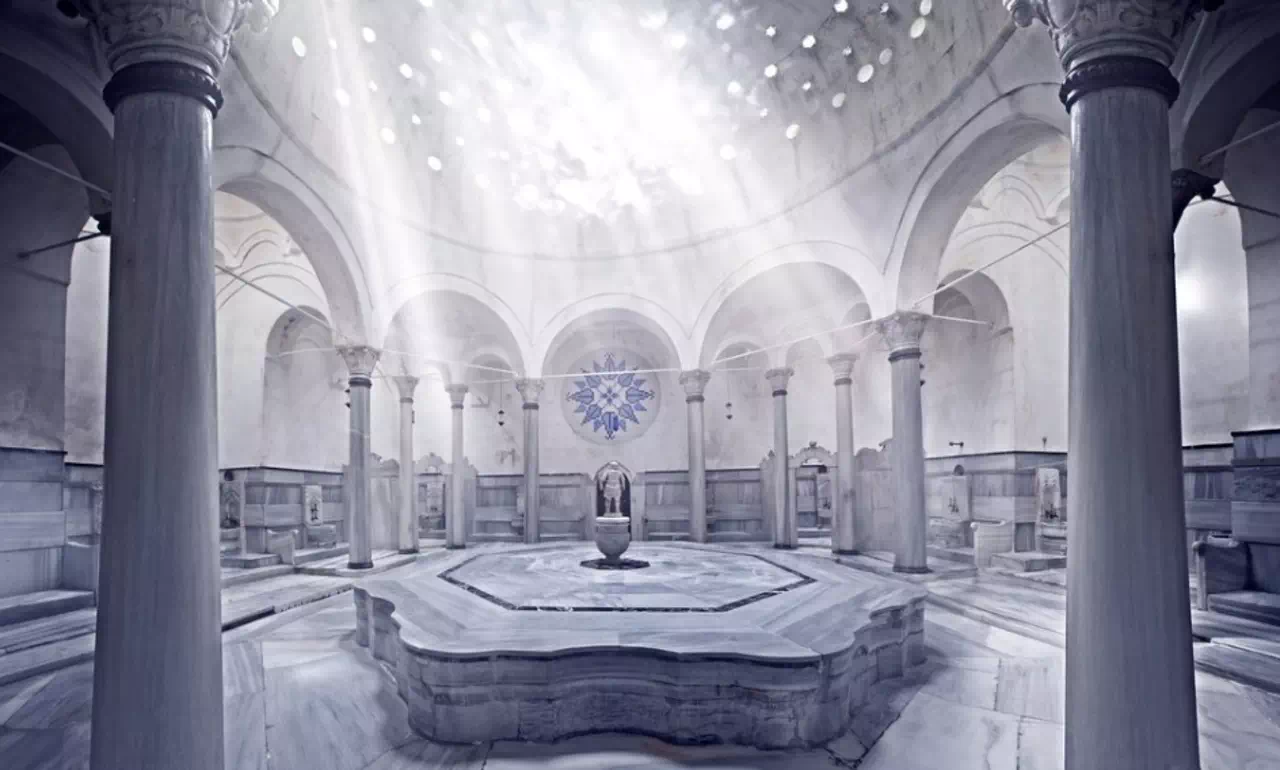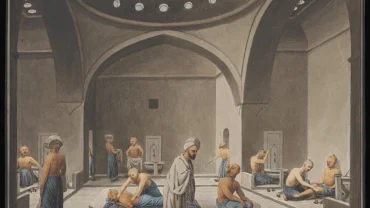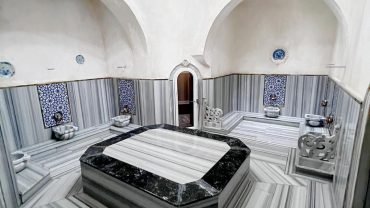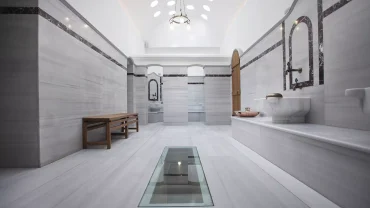When you step into Cagaloglu Hamam, one of Istanbul’s most prestigious Turkish baths, you’re not just entering a place of relaxation—you’re walking into a masterpiece of architectural innovation that defied Ottoman traditions. Built in 1741, Cagaloglu Hamam stands as the last great public bath constructed during the Ottoman Empire, but what makes it truly extraordinary is its revolutionary baroque architecture that broke away from centuries-old Islamic design principles.

Architectural Revolution in Ottoman Hammam Design
Cagaloglu Hamam’s construction marked a bold departure from centuries-old Ottoman hammam design traditions. This transformation wasn’t a simple aesthetic choice—it represented a shift in cultural priorities and architectural ambition. Before examining the specific changes, it’s important to understand the hallmarks of classic Ottoman hammam architecture and why Cagaloglu Hamam’s designers chose to break from them.
Classic Ottoman Hammam Architecture Features
To understand why Cagaloglu Hamam is so remarkable, we must first examine traditional Ottoman hamam architecture. Classic Ottoman baths followed strict Islamic architectural principles established by master architect Mimar Sinan and his predecessors. These traditional hammams featured:
- Symmetrical layout with identical men’s and women’s sections
• Simple dome structures with minimal decorative elements
• Standard changing rooms arranged in basic geometric patterns
• Traditional heating systems using wood-fired furnaces
• Islamic calligraphy as the primary decorative element
Cagaloglu Hamam challenged every single one of these conventions. Unlike traditional Ottoman baths that emphasized spiritual purification through architectural simplicity, Cagaloglu Hamam introduced European baroque sensibilities into Islamic sacred space design. The result was a hammam that looked unlike anything built in the Ottoman Empire before 1741.
Cagaloglu Hamam’s Surprising Differences
What immediately strikes visitors to Cagaloglu Hamam is its departure from orthodox Islamic architecture. The baroque influence is evident from the moment you approach the building. Where traditional Ottoman hammams featured modest, inward-looking facades, Cagaloglu Hamam displays ornate baroque elements that seem almost theatrical in their grandeur.
The most shocking difference lies in the interior spatial arrangement. Traditional Ottoman hammams were designed as meditation spaces where architecture served spiritual contemplation. Cagaloglu Hamam, however, was conceived as a palace of sensory experience where baroque architectural drama enhances the bathing ritual itself.
Architectural Transformation in 18th Century Istanbul
The architectural revolution embodied by Cagaloglu Hamam didn’t happen in isolation. The early 18th century marked a period when the Ottoman Empire was increasingly open to European artistic influences. Sultan Mahmud I, who commissioned Cagaloglu Hamam, was particularly fascinated by European baroque aesthetics and encouraged their integration into Ottoman architecture.
This cultural shift explains why Cagaloglu Hamam represents such a dramatic departure from traditional hammam design. The sultan wanted his bath to rival the grandest European palaces, resulting in architectural choices that would have been unthinkable just decades earlier.
Baroque Influence Reflected in Cagaloglu Hamam
The influence of European baroque architecture on Cagaloglu Hamam is evident both inside and out. From the ornate facades to the intricate spatial sequences, the hammam captures the theatricality and drama typical of the baroque movement. This section explores how baroque principles were adapted to fit within Islamic architectural traditions, resulting in a uniquely Ottoman interpretation of European style.
European Baroque Art’s Entry into Ottoman Empire
The baroque movement that transformed Cagaloglu Hamam originated in 17th-century Europe, emphasizing dramatic lighting, elaborate ornamentation, and emotional impact through architectural grandeur. When these ideas reached the Ottoman court, they created a cultural revolution that Cagaloglu Hamam perfectly exemplifies.
European diplomatic missions and trade relationships exposed Ottoman architects to baroque principles, which they adapted to Islamic architectural requirements. Cagaloglu Hamam became the testing ground for this cultural fusion, resulting in a hammam that incorporated:
- Dramatic spatial sequences reminiscent of baroque churches
• Elaborate decorative programs featuring European-inspired motifs
• Complex lighting schemes using baroque architectural techniques
• Theatrical spatial arrangements designed to create emotional impact
Sultan Mahmud I Era’s Architectural Reforms
Sultan Mahmud I’s reign (1730-1754) marked a turning point in Ottoman architecture, and Cagaloglu Hamam stands as the most ambitious example of his architectural vision. The sultan deliberately sought to modernize Ottoman architecture by incorporating European baroque elements while maintaining Islamic functional requirements.
Cagaloglu Hamam was specifically commissioned to generate revenue for the sultan’s library in Hagia Sophia, but its architectural program went far beyond mere functionality. The sultan wanted Cagaloglu Hamam to demonstrate Ottoman sophistication and cultural adaptability to European visitors, making it a diplomatic statement as much as a public bath.
Suleyman Aga and Abdullah Aga’s Innovative Design
The revolutionary architecture of Cagaloglu Hamam resulted from the collaboration between chief architect Suleyman Aga and master builder Abdullah Aga. These architects faced the unprecedented challenge of creating a hammam that satisfied traditional Islamic requirements while incorporating baroque architectural innovations.
Their solution was brilliant: they maintained the essential functional elements of Ottoman hammam design while completely reimagining the decorative and spatial vocabulary. Cagaloglu Hamam thus became the first Ottoman hammam to successfully integrate European baroque aesthetics with Islamic architectural principles.

Cagaloglu Hamam’s Unique Architectural Details
Beyond its overall baroque influence, Cagaloglu Hamam stands out for specific architectural features that are unmatched in Ottoman hammam history. These elements blend functionality with artistry, transforming essential hammam spaces into architectural showpieces. Each design choice—whether structural, decorative, or spatial—was intended to elevate the bathing ritual into a multisensory experience.
Octagonal Central Stone and Eight Marble Columns Dome
The most striking architectural feature of Cagaloglu Hamam is its revolutionary dome structure supported by eight marble columns—a design completely unprecedented in Ottoman hammam architecture. Traditional Ottoman baths featured simple circular or square central spaces, but Cagaloglu Hamam’s octagonal central stone (göbek taşı) creates a baroque architectural drama that transforms the bathing experience.
These eight marble columns don’t merely support the dome; they create a theatrical architectural framework that guides visitors’ eyes upward toward the baroque-influenced ceiling. The columns themselves feature decorative capitals that incorporate both Islamic and baroque design elements, creating a unique architectural vocabulary that exists nowhere else in Ottoman architecture.
The octagonal central stone arrangement at Cagaloglu Hamam also serves practical purposes. The eight-sided design creates more intimate alcoves around the perimeter while maintaining the central gathering space essential to hammam social culture.
Different Arrangement of Elephant Eye Windows
Traditional Ottoman hammams featured simple “elephant eye” (fil gözü) windows arranged in geometric patterns to provide natural lighting while maintaining privacy. Cagaloglu Hamam revolutionized this approach by creating a complex lighting scheme that incorporates baroque theatrical principles.
The elephant eye windows at Cagaloglu Hamam are arranged to create dramatic light and shadow effects throughout the day. Unlike traditional hammams where lighting was purely functional, Cagaloglu Hamam’s window arrangement was designed to create emotional and aesthetic impact through carefully orchestrated illumination patterns.
This innovative lighting design makes Cagaloglu Hamam feel more like a baroque cathedral than a traditional Islamic bath, creating an atmosphere of grandeur that enhances the bathing ritual’s sensory impact.
Structural Features That Distinguish from Classic Ottoman Hammams
While Cagaloglu Hamam retains the core functional layout of traditional Ottoman hammams, its execution is anything but conventional. The arrangement of spaces, decorative details, and overall spatial experience reflect an architectural ambition that redefined what a public bath could be. The following features highlight how Cagaloglu Hamam’s designers reimagined traditional forms.
Baroque Arrangement of Changing Rooms
The changing rooms (camekan) at Cagaloglu Hamam showcase the most dramatic architectural departure from traditional Ottoman hammam design. Traditional hammams featured simple, utilitarian changing areas arranged around a central courtyard. Cagaloglu Hamam transformed this functional space into a baroque architectural experience.
The changing rooms at Cagaloglu Hamam feature elaborate decorative programs including baroque-influenced architectural details, complex spatial arrangements, and dramatic lighting schemes. These spaces feel more like reception halls in a baroque palace than simple changing facilities in a public bath.
This architectural transformation reflects Cagaloglu Hamam’s role as a cultural bridge between Ottoman and European architectural traditions. The changing rooms serve as an introduction to the baroque architectural experience that awaits visitors in the main bathing areas.
Innovative Planning of Cold and Hot Sections
Traditional Ottoman hammams featured a simple progression from cold (soğukluk) to warm (ılıklık) to hot (sıcaklık) sections. Cagaloglu Hamam maintained this functional organization while completely reimagining the architectural expression of each zone.
The cold section at Cagaloglu Hamam incorporates baroque spatial drama through complex ceiling arrangements and decorative programs. Rather than serving merely as a transition space, the cold section becomes an architectural experience in its own right, preparing visitors for the baroque grandeur of the hot sections.
The hot section represents Cagaloglu Hamam’s most revolutionary architectural achievement. The baroque-influenced dome structure, elaborate column arrangements, and theatrical lighting create an atmosphere of almost religious grandeur that transforms the traditional hammam experience into something approaching European spa luxury.
The Story of the Strangely Shaped Marble Arch
One of Cagaloglu Hamam’s most puzzling architectural features is the “strangely shaped marble arch” at the entrance, which has mystified architectural historians for centuries. This arch incorporates baroque decorative elements that don’t correspond to any known Ottoman architectural tradition.
The arch appears to represent an experimental fusion of baroque and Islamic architectural vocabularies, creating a unique design that exists nowhere else in Ottoman architecture. Its unusual proportions and decorative program suggest that the architects of Cagaloglu Hamam were pushing the boundaries of acceptable Islamic architectural practice.
This architectural anomaly makes Cagaloglu Hamam a crucial document of cultural transformation in 18th-century Ottoman architecture, showing how Islamic and European architectural traditions could be creatively combined.
Cagaloglu Hamam Architecture’s Place in Istanbul Hammam Tradition
Situated within the broader context of Istanbul’s hammam heritage, Cagaloglu Hamam occupies a unique position. It both honors the Islamic bathing tradition and challenges its visual and spatial norms. By stepping outside the conventions established by legendary architects like Mimar Sinan, Cagaloglu Hamam set a precedent for future architectural experimentation in the Ottoman Empire.
Departure from Mimar Sinan Tradition
Cagaloglu Hamam represents the most dramatic departure from the architectural tradition established by Mimar Sinan, the great Ottoman architect whose hammam designs defined Islamic bathing architecture for centuries. While Sinan’s hammams emphasized spiritual purification through architectural simplicity, Cagaloglu Hamam prioritizes sensory luxury through baroque architectural drama.
This departure wasn’t merely stylistic; it represented a fundamental shift in Ottoman cultural values. Cagaloglu Hamam’s baroque architecture reflects an Ottoman Empire increasingly confident in its ability to adapt and incorporate European cultural innovations while maintaining Islamic identity.
The architectural revolution embodied by Cagaloglu Hamam influenced subsequent Ottoman architectural projects, establishing a precedent for cultural fusion that would characterize later Ottoman architecture.
Importance in 18th Century Ottoman Architectural School
Cagaloglu Hamam stands as the most important example of 18th-century Ottoman architectural innovation, demonstrating how Islamic and European architectural traditions could be successfully integrated. The hammam’s baroque elements established new possibilities for Ottoman architects while maintaining essential Islamic functional requirements.
The architectural success of Cagaloglu Hamam encouraged other Ottoman architects to experiment with European design elements, leading to a flowering of cultural fusion in 18th-century Ottoman architecture. The hammam thus represents a crucial turning point in Islamic architectural history.
Impact on Modern Hammam Architecture
The architectural innovations pioneered at Cagaloglu Hamam continue to influence modern hammam design worldwide. Contemporary spa architects studying Cagaloglu Hamam’s baroque elements have developed new approaches to luxury bathing facility design that incorporate both traditional Islamic and European architectural elements.
Modern luxury hammams in Istanbul and beyond often reference Cagaloglu Hamam’s architectural innovations, particularly its dramatic lighting schemes, elaborate decorative programs, and theatrical spatial arrangements. The hammam’s influence extends far beyond Turkey, inspiring spa design throughout the Mediterranean and Middle East.
Cagaloglu Hamam thus represents not just a historical architectural monument, but a living influence on contemporary design thinking about luxury, spirituality, and cultural fusion in architecture.





Comment (0)